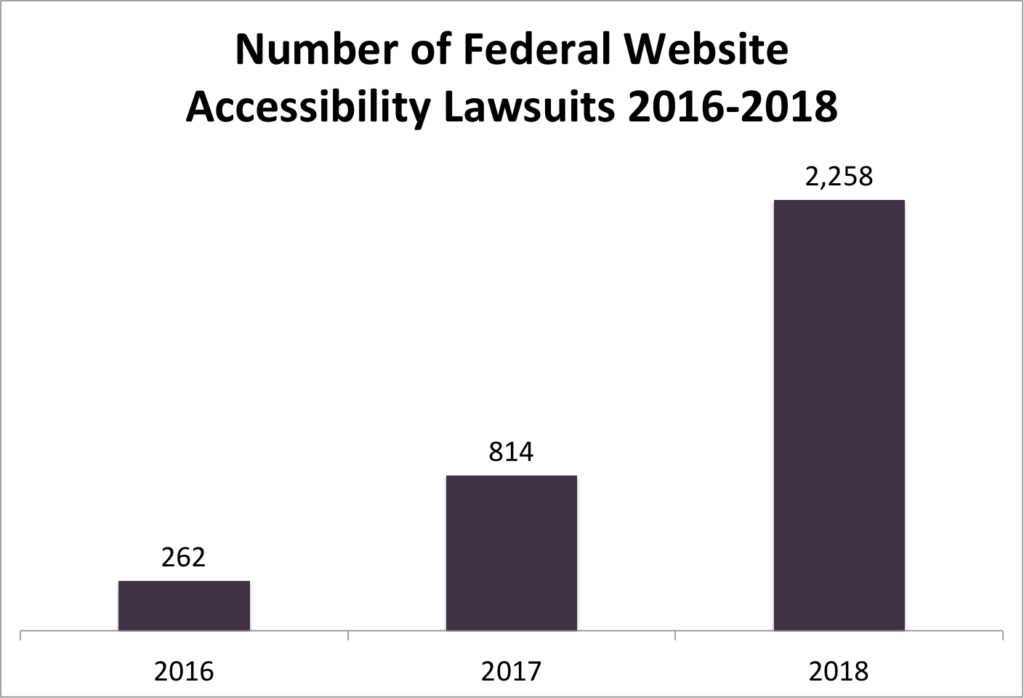Over the last few years, there has been a flood of federal lawsuits and threatening demand letters sent to organizations large and small for having websites that are inaccessible to those with certain disabilities.
In fact, the number of website accessibility lawsuits filed in federal court has nearly tripled in each of the last two years.
According to AdaTitleIII.com, there were at least 2,258 digital accessibility lawsuits in 2018 – a dramatic increase from the 814 such lawsuits in 2017 and the 262 filed in 2016.

What Are Digital Accessibility Lawsuits?
Each of these lawsuits was filed in federal court under Title III of the Americans with Disabilities Act of 1990.
This civil rights law encompasses a wide range of issues but generally ensures that individuals with disabilities aren’t discriminated against in areas of public life.
The ADA is broken down into five different titles, each dealing with a different area of focus (i.e. employment, telecommunications, state and local government, etc).
Title III is the most important one as far as websites are concerned as it states that places of public accommodation are prohibited from discriminating against individuals with disabilities.
Originally, this meant providing accommodations such as accessible parking spaces, wheelchair ramps, counters of a certain height, etc.
But in response to the increasing importance of the Internet in all aspects of modern life, some federal courts have started ruling that websites are covered by Title III of the ADA as well.
And for good reason as it’s estimated that over 90% of current websites are not accessible to those with disabilities.
But the general lack of digital accessibility across the Internet can only partially account for the recent uptick in federal litigation.
After all, inaccessible websites are nothing new while the rising atmosphere of litigation is.
Why Has There Been Such a Rapid Explosion of Digital Accessibility Lawsuits?
The fact that there are no explicit federal guidelines which dictate the difference between an accessible website and an inaccessible one has contributed greatly to the recent proliferation of digital accessibility lawsuits.
Title III of the ADA has no explicit mention of websites as it was written during the Internet’s infancy. Without definitive regulations in place, federal courts have delivered conflicting verdicts on a range of different issues related to Title III and website accessibility.
For example, some courts have ruled that all websites are covered by Title III of the ADA while others have ruled that only websites for organizations with a physical location are covered.
Yet others still have ruled that websites are not covered at all.
Due to the conflicting nature of federal rulings combined with the lack of explicit federal regulations concerning websites, an environment of rampant litigation has taken hold and continues to grow.
It’s important to note that under the law, the Department of Justice is charged with regulating and enforcing Title III of the ADA.
In 2010, the DOJ under the Obama Administration announced their plan to go through the rulemaking process to create website accessibility regulations.
However, due to the ever changing nature of web technology, the process faced numerous challenges and was delayed for many years.
It had still not been completed by 2017 when Attorney General Jeff Sessions officially placed the website accessibility rulemaking process on the DOJ’s “inactive list” – effectively killing any chance of the DOJ clarifying website regulations in the near future.
Since it seems highly unlikely that the DOJ would recommence the rulemaking process given the Trump Administration’s aversion to federal regulations, Congress could theoretically step in to amend the law and clarify how it applies to digital accessibility.
In 2018, the House of Representatives passed the ADA Education and Reform Act – legislation geared to combat the rising tide of Title III lawsuits. But the bill was not specific to digital accessibility – instead creating steps that plaintiffs must go through before they can sue an organization under Title III. As of publication, this bill is stuck in the Senate and has not yet been brought up for a vote.
Given the current political climate, it seems unlikely that congress will pass a bill that specifically defines digital accessibility regulations.
This leaves the only chance for clarification to come from the federal court system. Unfortunately that will take a long time, and as already noted, the courts are partly to blame for the currently murky situation.
What Can I Do to Protect My Business?
Unfortunately, there seems to be no end in sight to the current litigation environment.
While the current status of rampant lawsuits can seem overly burdensome, there is no denying the need for greater website accessibility across the Internet.
After all, the Internet plays an increasingly important role in modern life, and 71% of those with disabilities report that they have to leave a website right away if it does not offer an accessible experience.
In the majority of settled digital accessibility lawsuits, the courts have ordered defendants to update their websites to comply with the Web Content Accessibility Guidelines (WCAG) AA.
For all these reasons, we recommend auditing and updating your website to make sure it complies with WCAG 2.1 AA.
That way, you can rest assured that your website can be enjoyed by all visitors while also limiting your exposure to litigation.
Getting your website to meet WCAG compliance can seem like a daunting undertaking – especially if you are brand new to digital accessibility.
That’s why we strongly recommend that you sign up for a free, no-obligation consultation with one of our accredited accessibility experts.
We will answer any questions you have regarding website accessibility, your organization’s exposure to litigation, and how we can help you make the digital accessibility compliance process as easy as possible.